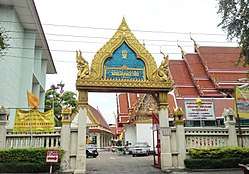Phlapphla Chai
Phlapphla Chai (Thai: พลับพลาไชย, pronounced [pʰláp.pʰlāː t͡ɕʰāj]) is a road in Bangkok's Pom Prap and Wat Thepsirin sub-districts, Pom Prap Sattru Phai District and also the five-way intersection of the road with Luang and Maitri Chit Roads. Phlapphla Chai Road separates from the left side of Charoen Krung Road at Plaeng Nam intersection, extending as far as it reaches Bamrung Mueang Road at the area near Hua Chiew Hospital and terminating at Kasat Suek Intersection, with a total length of 1.1 km (0.68 mi). It is part of Bangkok's Chinatown.


History
The name Phlapphla Chai comes from Wat Phlapphla Chai (วัดพลับพลาไชย), a wat (Thai temple) site on the side of Phlapphla Chai Road. The temple was built in the Ayutthaya period and was used for prisoner executions during the Thonburi Kingdom. The name of the temple in that era was Wat Khok (วัดโคก). In the reign of King Vajiravudh (Rama VI), it was used as a practice field for the Wild Tiger Corps and he gave it the new name of Wat Phlapphla Chai, which translates to 'Victory Pavilion', alluding to the pavilion built for the king inside the temple.
In the evening on 3 July 1974, Phlapphla Chai was the site of the "Chinatown Riots",[1] which left 26 dead and more than 120 injured. The riots started when two police officers arrested a taxi driver for illegal parking. He resisted and yelled that they were beating him. His yelling caused crowds to gather at Phlapphla Chai Police Station, eventually escalating into a riot and spread to nearby areas such as Hua Lamphong, July 22nd Circle, King Chulalongkorn Memorial Hospital, Rama IV Road, Wang Burapha. Protesters burned public places, threw bombs, and fired at police officers, who were unable to control the situation. The riots continued for four days until the government of prime minister Sanya Dharmasakti declared a state of emergency. The incident finally ended after soldiers and police used force to quell the rioters. The incident is considered to be one of the first large riots since the Oct 14 event.[2]
Phlapphla Chai is one of the areas most populated by those of Thai Chinese descent. It is not far from Yaowarat or Charoen Krung Roads and contains a number of restaurants and street food vendors in the surrounding area. Some of them were chosen to be Bib Gourmand from Michelin Guide as well.[1][2][3][4][5]
Nearby places
- Wat Khanikaphon
- Poh Teck Tung Foundation
- Bangkok Metropolitan Administration General Hospital (Klang Hospital)
References
- Kasetsiri, Charnvit (2012). Thailand Timeline 1942-2011 (in Thai). Bangkok: Post Books. ISBN 9789742280703.
- Bunnag, Rome (2016-04-11). "น้ำผึ้งหยดเดียว! แค่ ตร.จราจรจับแท็กซี่ กลายเป็นจลาจลจน ตร.รับไม่ไหว ต้องประกาศภาวะฉุกเฉิน ส่งรถถังเข้าปราบ!!" [Make a mountain out of a molehill! just a traffic police to arrest a taxi became a riot until the police couldn't control must to declare a state of emergency send a tank to defeat!!]. Manager Daily (in Thai).
- "ไหว้พระทำบุญ เยี่ยมชุมชนคนจีน ที่ "ย่านพลับพลาไชย"" [Pay homage visit Chinatown at "Phlapphla Chai neighbourhood"]. Manager Daily (in Thai). 2015-01-23.
- "Poon Lert Room (Phlapphla Chai intersection)". Michelin Guide.
- "Ann Guay Tiew Kua Gai". Michelin Guide.